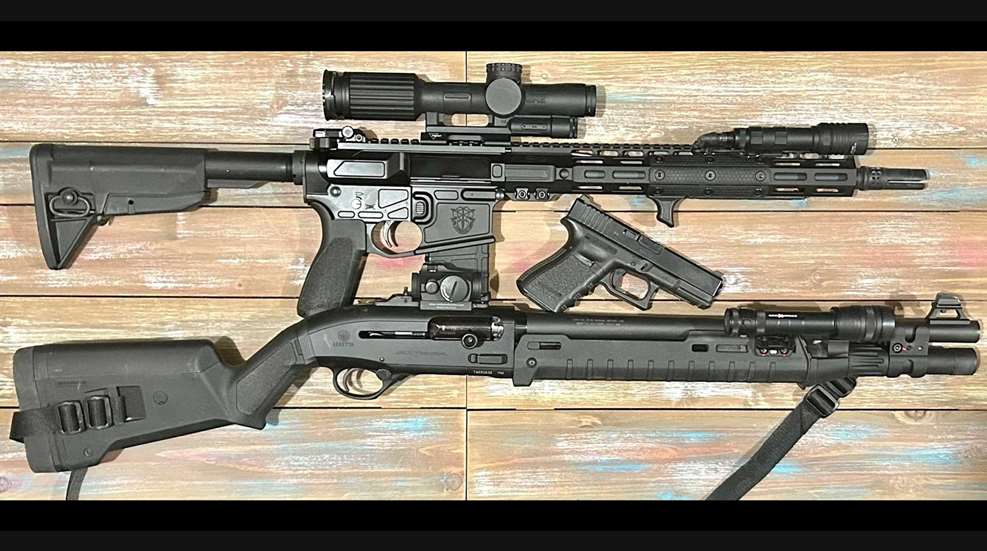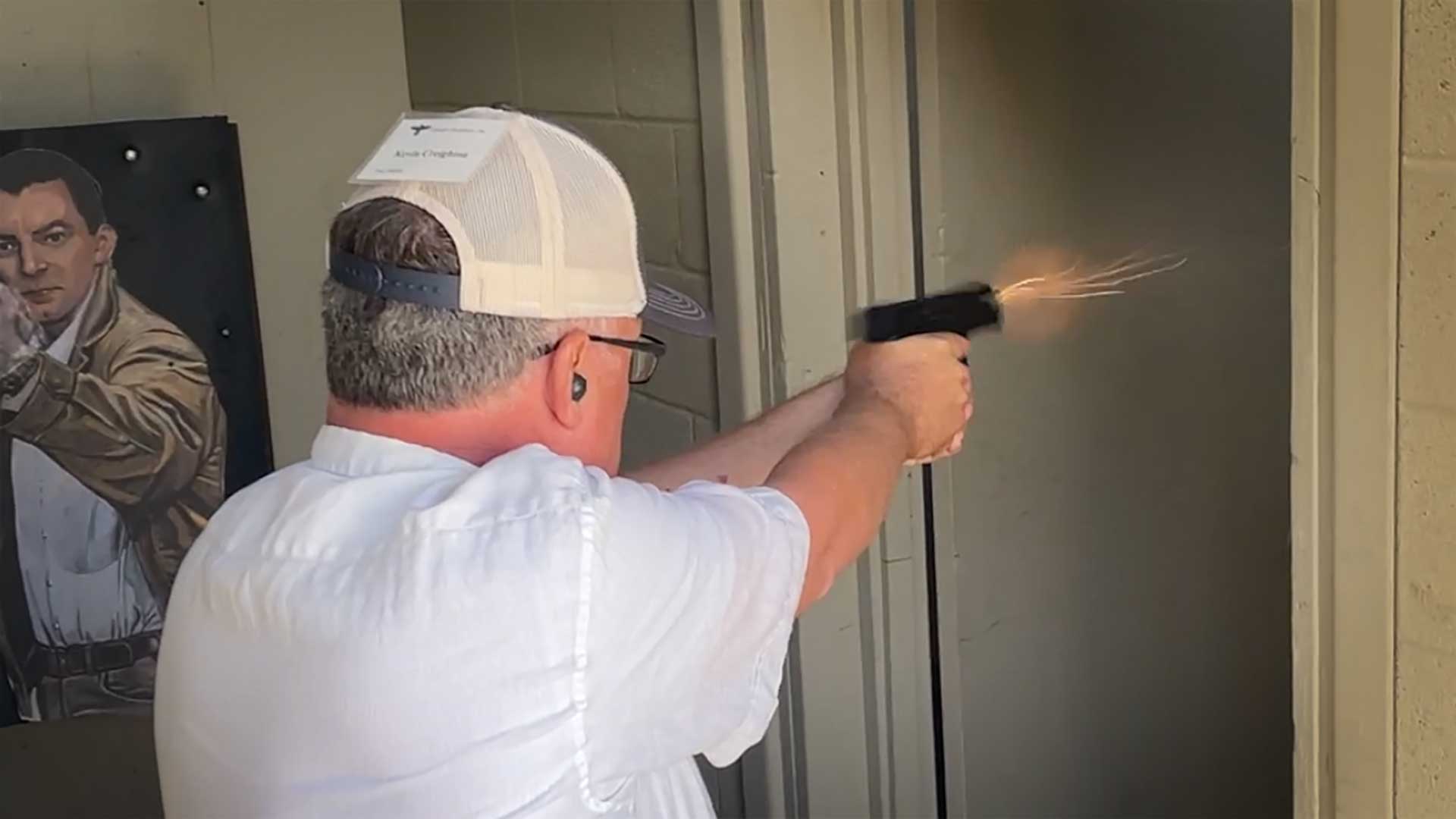
Ask the question, “What is the best gun for home defense?” anywhere on the Internet and you will soon see heated debate with dogmatic answers from all sides. Some people will advocate for handguns, others for AR-15 pattern carbines or pistol-caliber carbines and others for shotguns. The reality is more nuanced and complex, and there is no such thing as “The Best Home Defense Gun.” What you need to be looking for is the best home defense gun for you, based on a number of criteria. The criteria we should use to select an ideal home defense gun will be determined by our individual skill and experience, the layout of our residence, and the specifics of your own specific home defense plan.
Your Comfort Level
The first and most immediate factor in selecting a home defense gun is your individual skill and comfort level. If, heaven forbid, you woke tonight to an intruder breaking into your home, then grab the firearm you are most proficient with. Skill with a handgun surpasses using a more powerful carbine or shotgun if you lack competence with those particular guns. Proficiency matters more than the specific gun type in a home defense situation. If you determine a particular firearm suits your needs long-term, invest time in training and practice until you are competent and confident. Meanwhile, use the gun you can reliably score hits with, as getting good hits is what matters in any home defense scenario.
Barricade or Move?
The next criterion is considering whether you'll likely be stationary or barricaded awaiting intruders, or if you may need to move through your home to secure loved ones and potentially encounter intruders while moving. It's tactically advantageous to barricade and let intruders come to you, if possible, as defending is easier than attacking within a familiar layout. Positioning yourself to protect family members while waiting for intruders is ideal. In such cases, a rifle or shotgun can be a powerful tool to safeguard your loved ones' lives.
Unfortunately, not all homes allow for easy barricading with loved ones behind you in case of an intrusion. Some homes, like those with split floor plans, may have the master bedroom on one side and other bedrooms on the opposite side, requiring you to move to protect your family. In this situation, the goal might not be to actively search for intruders, but to reach your kids' sleeping area and secure it. While moving, you may encounter intruders at close quarters near corners or doorways, presenting unique challenges.

In my home, if I must move alone while armed, I prefer a handgun to a long gun. My 20-year service in the US Army, primarily as a Green Beret, made me quite comfortable navigating structures with long guns in team situations. However, at home as a private citizen, I lack a team that can support me if I find myself in a wrestling match over my long gun. To prevent anyone from grabbing my gun in close quarters, I find it easier to use a handgun while navigating tight spaces alone, such as doorways and hallways. This surprises many people, but an intruder getting their hands on my gun is the worst case scenario and I’m willing to trade the greater power of long guns for the ease of navigation and retention of a handgun.
Over-Penetration
Now let’s examine some common discussion points about home defense guns and examine their validity. Perhaps the most common is “over-penetration,” meaning bullets going through bad guys or other barriers and having enough power left over to kill loved ones, neighbors, etc. Discussions invariably advise one type of gun and/or ammo over another to avoid it. Here’s the simplest way I can summarize the issue: In modern American homes, there is very little that will stop a projectile out of a handgun, carbine, or shotgun. While it is true that different loads out of different types of guns will go through a few more or a few less layers of drywall, the reality is that all of the loads that will be good at stopping humans will go through many layers of drywall before coming to a stop. The solution, assuming you’re not using anything irresponsible like a magnum-caliber hunting rifle, is not missing and accounting for each round you fire. Bad guys make the best backstops, and thoughtfully chosen loads for handguns, carbines, and shotguns will ultimately result in any “shoot-throughs” having very little energy left if they make it out the other side of your target. When it comes to over-penetration, there won’t be that radical a difference between most handgun, carbine, and shotgun rounds if you miss, and if you hit the intruder solidly (which at interior distances you should plan on and train for) then shoot-throughs that lead to negative consequences are extremely, extremely rare.
Capacity?
Another hot topic is capacity. Social media is full of people espousing the superiority of the AR-15 pattern carbine over the shotgun because of the carbine’s standard capacity of 30 round magazines versus shotgun magazine tubes holding four to eight shells; same with semi-automatic pistols versus revolvers in the handgun realm. Frankly, with skill of the defender being equal, these are not issues we have seen impacting outcomes anywhere in the real world when it comes to private citizens in their homes.
Given the AR-15 pattern carbine’s low recoil and ability to shoot it rapidly, what typically occurs in close range engagements is a skilled shooter can place 4-7 accurate rounds on a bad guy before he leaves the sight picture and goes to the ground. That means that a carbine with 30 rounds has four to seven “servings of bad guy” to use the term coined by famed trainer Tom Givens. Regarding shotguns at close range, loaded with quality buckshot (I strongly advise avoiding birdshot, which penetrates very poorly on human sized targets out of self-defense shotguns), if there’s ever been an unarmored bad guy who required a follow up shot when hit high-center-mass, I’ve not heard of it. An accurate load of eight or nine-pellet buckshot at close range is as close to an “off-switch” as a citizen defender is likely to have access to, making a home defense shotgun with a four to seven shell capacity tube a four to seven ”servings of bad guy” gun - same as an AR-15 pattern carbine. Within the home defense context and the actual demands of realistic scenarios, the capacity difference is not so great as many imagine.
Which Is Best?
In the short term, choose whatever firearm you are most proficient with. In the long-term evaluate whether you expect to be able to barricade, in which case a long-gun might be ideal for its power and precision, or whether you might have to move through your house during a home defense scenario, in which case a handgun might provide benefits. If you do opt for a long-gun, carbines and shotguns are both excellent choices if the user’s skill level is sufficient. People defend their choices emotionally on the Internet, but the reality is that handguns, AR-15 pattern or pistol caliber carbines, and shotguns are all more than adequate to the home defense task. I personally have a pump-action shotgun staged in a rapid-access safe for barricade situations, and a semi-automatic handgun similarly stored in case I need to move to secure my kids. That said, I wouldn’t sweat it at all if I had to use an AR-15 and a medium framed revolver instead. Ultimately, preparedness, planning, and skill trumps tool selection, and if your chosen tool is reliable and you are skilled in its use, you can be confident that you can protect your loved ones and yourself during a home invasion.


































